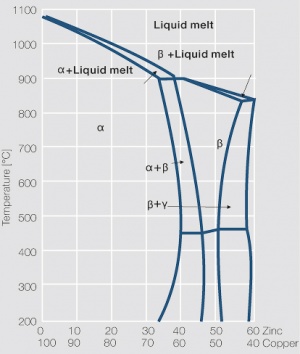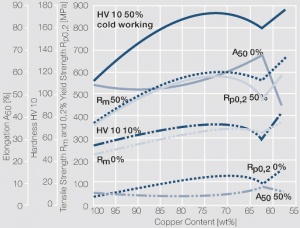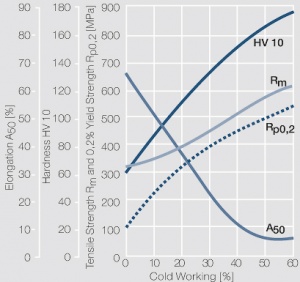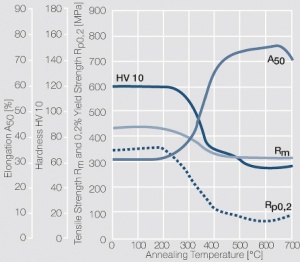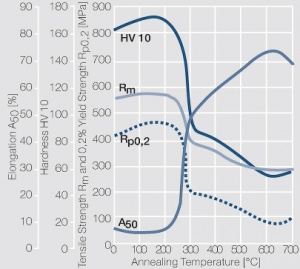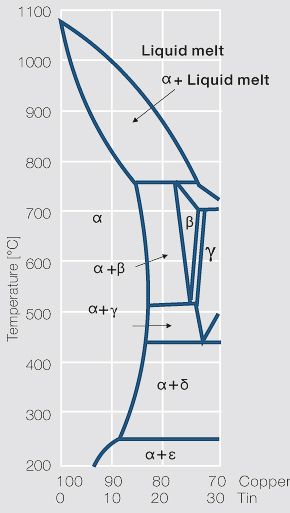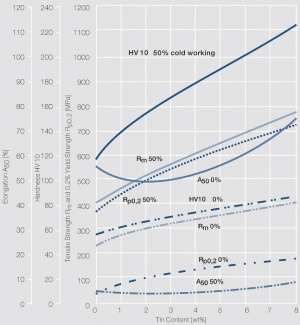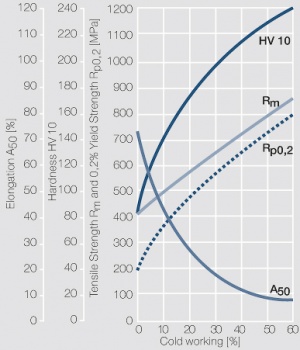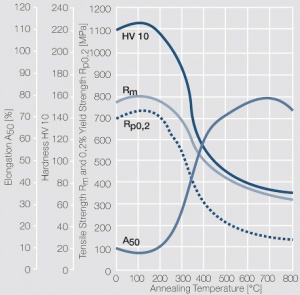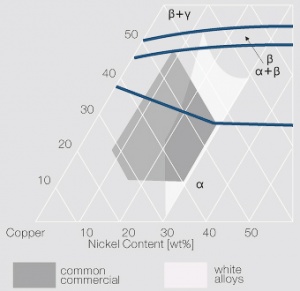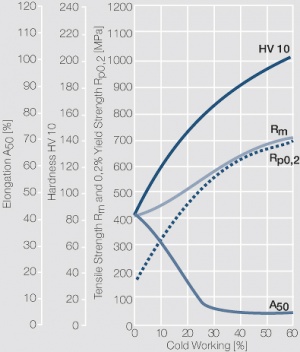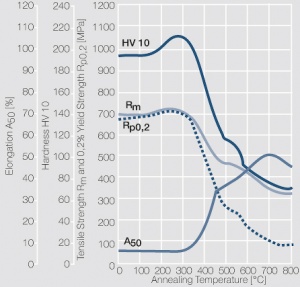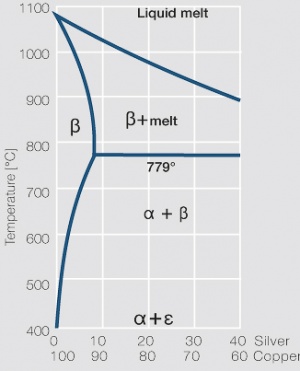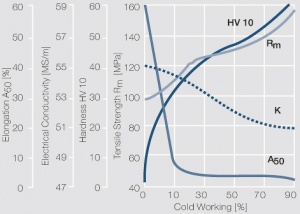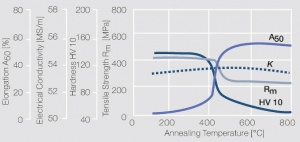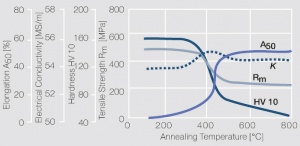Naturharte Kupfer-Legierungen
Legierungen wie Messinge (CuZn), Zinnbronzen (CuSn) und Neusilber (CuNiZn), bei denen die gewünschte Festigkeit durch Kaltumformung erzeugt wird, werden als naturharte Legierungen bezeichnet. Zu dieser Gruppe sind auch die Silberbronzen mit Silbergehalten von 2 bis 6 Massen-% zu zählen.
Contents
Kupfer-Zink-Legierungen (Messing)
Kupfer-Zink-Legierungen finden wegen ihrer ausreichend hohen elektrischen Leitfähigkeit, der gegenüber Kupfer höheren Festigkeit bei noch guter Verarbeitbarkeit und des günstigen Preises breite Anwendung als Kontaktträgerwerkstoffe in Schaltgeräten der Energietechnik (Table 1 und Table 2). Besonders geeignet sind die sehr gut kaltbildsamen Messinge bis 37 Massen-% Zn, die nach dem Zustandsdiagramm ausschließlich aus der α-Phase aufgebaut sind (Figure 1). Beachtenswert ist die starke Abhängigkeit der Dichte, der elektrischen Leitfähigkeit und der Festigkeitseigenschaften vom Zinkgehalt (Figure 2).
| Werkstoff Bezeichnung EN UNS |
Zusammensetzung [wt%] |
Dichte [g/cm3] |
Elektr. Leitfähigkeit | Elektr. Widerstand[μΩ·cm] | Wärmeleitfähigkeit [W/(m·K)] |
Lin. Ausdehnungskoeff. [10-6/K] |
E-Modul [GPa] |
Erweichungstemperatur (ca. 10% Festigkeitsabfall) [°C] |
Schmelzbereich [°C] | |
|---|---|---|---|---|---|---|---|---|---|---|
| [MS/m] | [% IACS] | |||||||||
| CuZn5 CW500L C21000 |
Cu 94 - 96 Zn Rest |
8.87 | 33 | 57 | 3.8 | 243 | 18.0 | 127 | 1055 - 1065 | |
| CuZn10 CW501L C22000 |
Cu 89 - 91 Zn Rest |
8.79 | 25 | 43 | 4.0 | 184 | 18.2 | 125 | 1030 - 1045 | |
| CuZn15 CW502L C23000 |
Cu 84 - 86 Zn Rest |
8.75 | 21 | 36 | 4.8 | 159 | 18.5 | 122 | ca. 250 | 1005 - 1025 |
| CuZn20 CW503L C24000 |
Cu 79 - 81 Zn Rest |
8.67 | 19 | 33 | 5.3 | 142 | 18.8 | 120 | ca. 240 | 980 - 1000 |
| CuZn30 CW505L C26000 |
Cu 69 - 71 Zn Rest |
8.53 | 16 | 28 | 6.3 | 124 | 19.8 | 114 | ca. 230 | 910 - 940 |
| CuZn37 CW508L C27200 |
Cu 62 - 64 Zn Rest |
8.45 | 15.5 | 27 | 6.5 | 121 | 20.2 | 110 | ca. 220 | 900 - 920 |
| CuZn23Al3Co CW703R C68800 |
Cu 73.5 Al 3.4 Co 0.4 Zn Rest |
8.23 | 9.8 | 17 | 10.2 | 78 | 18.2 | 116 | ca. 280 | 950 - 1000 |
| Werkstoff | Zustand | Zugfestigkeit Rm [MPa] |
0,2% Dehngrenze Rp02 [MPa] |
Bruchdehnung A50 [%] |
Vickershärte HV |
Biegeradius1) min senkrecht zur Walzrichtung |
Biegeradius1) min parallel zur Walzrichtung |
Federbiegegrenze σFB [MPa] |
Biegewechselfestigkeit σBW [MPa] |
|---|---|---|---|---|---|---|---|---|---|
| CuZn5 | R 230 R 270 R 340 |
230 - 280 270 -350 340 - 440 |
≤ 130 ≥ 200 ≥ 280 |
36 12 4 |
45 - 90 70 - 120 110 - 160 |
0 x t 0 x t |
0 x t 0 x t |
250 | 130 |
| CuZn10 | R 240 R 280 R 350 |
240 - 290 280 - 360 350 - 450 |
≤ 140 ≥ 200 ≥ 290 |
36 13 4 |
50 - 100 80 - 130 110 - 160 |
0 x t 0 x t |
0 x t 0 x t |
260 | 140 |
| CuZn15 | R 300 R 350 R 410 R 480 R 550 |
300 - 370 350 - 420 410 - 490 480 - 560 ≥ 550 |
≤ 150 ≥ 270 ≥ 360 ≥ 420 ≥ 480 |
16 8 3 1 |
85 - 120 100 - 150 125 - 155 150 - 180 ≥ 170 |
0 x t 0 x t 0 x t 1 x t |
0 x t 0 x t 1 x t 3 x t |
300 | 160 |
| CuZn20 | R 270 R 320 R 400 R 480 |
270 - 320 320 - 400 400 - 480 480 - 570 |
≤ 150 ≥ 200 ≥ 320 ≥ 440 |
38 20 5 3 |
55 - 105 95 - 155 120 - 180 ≥ 150 |
0 x t 0 x t 0 x t |
0 x t 0 x t 0 x t |
320 | 180 |
| CuZn30 | R 270 R 350 R 410 R 480 |
270 - 350 350 - 430 410 - 490 480 - 580 |
≤ 160 ≥ 200 ≥ 430 ≥ 430 |
40 21 9 4 |
95 - 125 120 - 155 150 - 180 170 - 200 |
0 x t 0 x t 0 x t 1 x t |
0 x t 1 x t 2 x t 3 x t |
330 | 180 |
| CuZn37 | R 300 R 350 R 410 R 480 R 550 |
300 - 370 350 - 440 410 - 490 480 - 560 550 - 640 |
≤ 180 ≥ 200 ≥ 260 ≥ 430 ≥ 500 |
38 19 8 3 |
55 - 105 95 - 155 120 - 190 ≥ 150 ≥ 170 |
0 x t 0 x t 0 x t 0.5 x t 1 x t |
0 x t 0 x t 0 x t 1 x t 3 x t |
350 | 190 |
| CuZn23Al3Co | R 660 R 740 R 820 |
660 - 750 740 - 830 ≥ 820 |
≥ 580 ≥ 660 ≥ 780 |
10 3 2 |
190 - 220 210 - 240 ≥ 235 |
0 x t 1 x t |
0 x t 2 x t |
≥ 400 | 230 |
1) t: Banddicke max 0,5 mm
Nachteile der Kupfer-Zink-Legierungen sind die mit steigendem Zinkgehalt zunehmende Neigung zur Spannungsrisskorrosion und das im Vergleich zu anderen Kupferlegierungen schlechte Spannungsrelaxationsverhalten.
Von den Sondermessingen kommt vor allem CuZn23Al3Co als Kontaktträgerwerkstoff zum Einsatz. Dieser Werkstoff erreicht wesentlich höhere Festigkeitswerte als die Standard-Messinge. Obwohl CuZn23Al3Co zu den naturharten Legierungen gerechnet wird, erreicht er bei geeigneter Anlassbehandlung eine ausgeprägte Festigkeitszunahme.
Figure 1 Zustandsdiagramm Kupfer-Zink für den Bereich 0 bis 60 Massen-% Zink
Figure 2 Festigkeitseigenschaften von Messing in Abhängigkeit vom Kupfergehalt (Kaltumformung 0 und 50%)
Figure 3 Verfestigungsverhalten von CuZn36 durch Kaltumformung
Figure 4 Erweichungsverhalten von CuZn36 nach 3h Glühdauer und einer Kaltumformung von 25%
Kupfer-Zinn-Legierungen (Zinnbronze)
Die Kupfer-Zinn-Legierungen CuSn6 und CuSn8 gelten dank ihrer günstigen Federeigenschaften und ihrer guten Verarbeitbarkeit als Standardwerkstoffe für federnde Kontaktteile in elektromechanischen Bauelementen, wie Steckverbindern, Schaltern und Relais (Table 3 und Table 4). Zum Einsatz kommen außerdem die Legierungen CuSn4 und CuSn5 (vor allem in den USA) sowie die Mehrstoffzinnbronze CuSn3Zn9. In Figure 6 ist die kupferreiche Seite des Zustandsdiagramms für das System Kupfer-Zinn dargestellt. Die durch Kaltumformung erzielbaren Festigkeitswerte sind denen des Messings überlegen (Bild 5.11). Sie steigen mit wachsendem Zinngehalt deutlich an. Am Beispiel von CuSn8 sind das Verformungs- und Erweichungsverhalten aufgeführt (Figure 8 and Figure 9). Das Relaxationsverhalten der Kupfer-Zinn- Legierungen ist bis ca. 100°C günstig, wird jedoch oberhalb 150°C deutlich schlechter.
| Werkstoff Bezeichnung EN UNS |
Zusammensetzung [wt%] |
Dichte [g/cm3] |
Elektr. Leitfähigkeit | Elektr. Widerstand[μΩ·cm] | Wärmeleitfähigkeit [W/(m·K)] |
Lin. Ausdehnungskoeff. [10-6/K] |
E-Modul [GPa] |
Erweichungstemperatur (ca. 10% Festigkeitsabfall) [°C] |
Schmelzbereich [°C] | |
|---|---|---|---|---|---|---|---|---|---|---|
| [MS/m] | [% IACS] | |||||||||
| CuSn4 CW450K C51100 |
Sn 3.5 - 4.5 P 0.01 - 0.4 Cu Rest |
8.85 | 12.0 | 20 | 8.3 | 118 | 18.0 | 120 | ca. 260 | 960 - 1060 |
| CuSn5 CW451K C51000 |
Sn 4.5 - 5.5 P 0.01 - 0.4 Cu Rest |
8.85 | 10.0 | 17 | 10.0 | 96 | 18.0 | 120 | ca. 260 | 940 - 1050 |
| CuSn6 CW452K C51900 |
Sn 5.5 - 7.0 P 0.01 - 0.4 Cu Rest |
8.80 | 9.0 | 15 | 11.1 | 75 | 18.5 | 118 | ca. 280 | 910 - 1040 |
| CuSn8 CW453K C52100 |
Sn 7.5 - 8.5 P 0.01 - 0.4 Cu Rest |
8.80 | 7.5 | 13 | 13.3 | 67 | 18.5 | 115 | ca. 320 | 875 - 1025 |
| CuSn3Zn9 CW454K C42500 |
Zn 7.5 - 10 Sn 1.5 - 3.5 P 0.2 Ni 0.2 Cu Rest |
8.75 | 12 | 28 | 6.2 | 120 | 18.4 | 126 | ca. 250 | 900 - 1015 |
| Werkstoff | Zustand | Zugfestigkeit Rm [MPa] |
0,2% Dehngrenze Rp02 [MPa] |
Bruchdehnung A50 [%] |
Vickershärte HV |
Biegeradius1) min senkrecht zur Walzrichtung |
Biegeradius1) min parallel zur Walzrichtung |
Federbiegegrenze σFB [MPa] |
Biegewechselfestigkeit σBW [MPa] |
|---|---|---|---|---|---|---|---|---|---|
| CuSn4 | R 290 R 390 R 480 R 540 R 610 |
290 - 390 390 - 490 480 - 570 540 - 630 ≥ 610 |
≤ 190 ≥ 210 ≥ 420 ≥ 490 ≥ 540 |
40 13 5 4 2 |
70 - 100 115 - 155 150 - 180 170 - 200 ≥ 190 |
0 x t 0 x t 0 x t 0 x t |
0 x t 0 x t 0 x t 1 x t |
420 | 200 |
| CuSn5 | R 310 R 400 R 490 R 550 R 630 R 690 |
310 - 390 400 - 500 490 - 580 550 - 640 630 - 720 ≥ 690 |
≤ 250 ≥ 240 ≥ 430 ≥ 510 ≥ 600 ≥ 670 |
45 17 10 6 3 |
75 - 105 120 - 160 160 - 190 180 - 210 200 - 230 ≥ 220 |
0 x t 0 x t 0 x t 0 x t 1 x t |
0 x t 0 x t 0 x t 1 x t 2 x t |
460 | 220 |
| CuSn6 | R 350 R 420 R 500 R 560 R 640 R 720 |
350 - 420 420 - 520 500 - 590 560 - 650 640 - 730 ≥ 720 |
≤ 300 ≥ 260 ≥ 450 ≥ 500 ≥ 600 ≥ 690 |
45 20 10 7 4 |
80 - 110 125 - 165 160 - 190 180 - 210 200 - 230 ≥ 220 |
0 x t 0 x t 0 x t 0 x t 1 x t |
0 x t 0 x t 0 x t 1 x t 2 x t |
480 | 230 |
| CuSn8 | R 370 R 450 R 540 R 600 R 660 R 740 |
370 - 450 450 - 550 540 - 630 600 - 690 660 - 750 ≥ 740 |
≤ 300 ≥ 280 ≥ 460 ≥ 530 ≥ 620 ≥ 700 |
50 23 15 7 4 |
90 - 120 135 - 175 170 - 200 190 - 220 210 - 240 ≥ 230 |
0 x t 0 x t 0 x t 1 x t 2 x t |
0 x t 0 x t 0 x t 1 x t 2 x t |
520 | 240 |
| CuSn3Zn9 | R 320 R 380 R 430 R 510 R 580 R 660 |
320 - 380 380 - 430 430 - 520 510 - 600 580 - 690 ≥ 660 |
≤ 230 ≥ 200 ≥ 330 ≥ 430 ≥ 520 ≥ 610 |
25 18 6 3 4 |
80 - 110 110 - 140 140 - 170 160 - 190 180 - 210 ≥ 200 |
0 x t 0 x t 0 x t 0 x t 1 x t |
0 x t 0 x t 0 x t 1 x t 2 x t |
500 | 210 |
1) t: Banddicke max 0,5 mm
Figure 5 Softening of CuZn36 after 3 hrs annealing after 50% cold working)
Figure 6 Phase diagram of the Cu-Sn system for the range of 0 – 30 wt% Sn)
Figure 7 Mechanical properties of tin bronze depending on the tin content (cold working 0 and 50%)
Figure 8 Strain hardening of CuSn8 by cold working
Figure 9 Softening of CuSn8 after 3 hrs annealing after 50% cold working
Copper-Nickel-Zinc Alloys (German Silver)
Despite its lower electrical conductivity, the good spring properties, high corrosion resistance, and the good workability make copper-nickel-zinc alloys a frequently used spring contact carrier in switches and relays. As illustrated in the phase diagram the most commonly used materials are in the α -range which means that they are single-phase alloys Figure 10. The formability and strength properties of german silver are comparable to those of the copper-tin alloys. The work hardening and softening behavior is illustrated on the example of CuNi12Zn24 in Figure 11 and Figure 12.
The relaxation behavior of Cu-Ni-Zn alloys is superior to the one for the tin bronzes. Additional advantages are the very good weldability, brazing properties, and the high corrosion resistance of these copper-nickel-zinc alloys.
| Material Designation EN UNS |
Composition [wt%] |
Density [g/cm3] |
Electrical Conductivity |
Electrical Resistivity [μΩ·cm] |
Thermal Conductivity [W/(m·K)] |
Coeff. of Linear Thermal Expansion [10-6/K] |
Modulus of Elasticity [GPa] |
Softening Temperature (approx. 10% loss in strength) [°C] |
Melting Temp Range [°C] | |
|---|---|---|---|---|---|---|---|---|---|---|
| [MS/m] | [% IACS] | |||||||||
| CuNi12Zn24 CW403J C75700 |
Cu 63- 66 Ni 11 - 13 Mn 0.5 Fe 0.3 Zn Rest |
8.67 | 4.4 | 7 | 30 | 42 | 18 | 125 | ca. 400 | 1020 - 1065 |
| CuNi18Zn20 CW409J C76400 |
Cu 60 - 63 Ni 17 - 19 Mn 0.5 Fe 0.3 Zn Rest |
8.73 | 3.3 | 5 | 23 | 33 | 17.7 | 135 | ca. 440 | 1055 - 1105 |
| CuNi18Zn27 CW410J C77000 |
Cu 53 - 56 Ni 17 - 19 Mn 0.5 Fe 0.3 Zn Rest |
8.70 | 3.3 | 5 | 23 | 32 | 17.7 | 135 | ca. 440 | 1050 - 1100 |
| Material | Hardness Condition |
Tensile Strength Rm [MPa] |
0,2% Yield Strength Rp02 [MPa] |
Elongation A50 [%] |
Vickers Hardness HV |
Bend Radius1) perpendicular to rolling direction |
Bend Radius1) parallel to rolling direction |
Spring Bending Limit σFB [MPa] |
Spring Fatigue Limit σBW [MPa] |
|---|---|---|---|---|---|---|---|---|---|
| CuNi12Zn24 | R 360 R 430 R 490 R 550 R ≥ 610 |
360 - 430 430 - 510 490 - 580 550 - 640 ≥ 580 |
≤ 230 ≥ 230 ≥ 400 ≥ 480 ≥ 580 |
35 8 6 3 2 |
80 - 110 110 - 150 150 - 180 170 - 200 ≥ 190 |
0 x t 0 x t 0 x t 0 x t |
0 x t 0 x t 0 x t 0 x t |
480 | 210 |
| CuNi18Zn20 | R 380 R 450 R 500 R 580 R ≥ 640 |
380 - 450 450 - 520 500 - 590 580 - 670 ≥ 640 |
≤ 250 ≥ 250 ≥ 410 ≥ 510 ≥ 600 |
27 9 5 2 |
85 - 115 115 - 160 160 - 190 180 - 210 ≥ 220 |
0 x t 0 x t 0 x t 0 x t |
0 x t 0 x t 0 x t 0 x t |
520 | 220 |
| CuNi18Zn27 | R 390 R 470 R 540 R 600 R ≥ 700 |
390 - 470 470 - 540 540 - 630 600 - 700 ≥ 700 |
≤ 280 ≥ 280 ≥ 450 ≥ 550 ≥ 680 |
30 11 5 2 |
90 - 120 120 - 170 170 - 200 190 - 220 ≥ 220 |
0 x t 0 x t 0 x t 0 x t |
0 x t 0 x t 0 x t 1 x t |
550 | 250 |
1) t: Strip thickness max. 0.5 mm
Figure 10 Copper rich region of the ternary copper-nickel-zinc phase diagram with indication of the more commonly available german silver materials
Figure 11 Strain hardening of CuNi12Zn24 by cold working
Figure 12 Softening of CuNi12Zn24 after 3 hrs annealing after 50% cold working
Copper-Silver-(Cadmium) Alloys (Silver Bronze)
Besides the low-allowed CuAg0.1 other copper materials with higher silver contents (2-6 wt%) are also used as contacts carrier materials. Some of them contain additionally 1.5 wt% Cd. The phase diagram Figure 13 shows that in principle the CuAg alloys can be precipitation hardened, but the possible increase in mechanical strength is rather small.
Copper-silver alloys have good spring properties and compared to other spring materials have a high electrical conductivity Table 7 and Table 8. The mechanical strength values in the strongly worked condition are comparable to those of the copper-tin alloys. Work hardening and softening behavior are shown for the example of CuAg2 (Figs. 13 – 15). For the relaxation behavior the silver bronzes are superior to German silver and tin bronze.
Because of their good spring properties combined with high electrical conductivity silver bronzes are suitable for the use contact springs in relays under higher current loads. Taking advantage of their high temperature stability they are also used as current carrying contacts in high voltage switchgear and as electrode material for resistance welding.
| Material Designation EN UNS |
Composition [wt%] |
Density [g/cm3] |
Electrical Conductivity |
Electrical Resistivity [μΩ·cm] |
Thermal Conductivity [W/(m·K)] |
Coeff. of Linear Thermal Expansion [10-6/K] |
Modulus of Elasticity [GPa] |
Softening Temperature (approx. 10% loss in strength) [°C] |
Melting Temp Range [°C] | |
|---|---|---|---|---|---|---|---|---|---|---|
| [MS/m] | [% IACS] | |||||||||
| CuAg2 not standardized |
Ag 2 Cu Rest |
9.0 | 49 | 85 | 2.0 | 330 | 17.5 | 123 | ca. 330 | 1050 - 1075 |
| CuAg2Cd1,5 not standardized |
Ag 2 Cd1,5 Cu Rest |
9.0 | 43 | 74 | 2.3 | 260 | 17.8 | 121 | ca. 350 | 970 - 1055 |
| CuAg6 not standardized |
Ag 6 Cu Rest |
9.2 | 38 | 66 | 2.4 | 270 | 17.5 | 120 | 960 - 1050 | |
| Material | Hardness Condition |
Tensile Strength Rm [MPa] |
0,2% Yield Strength Rp02 [MPa] |
Elongation A50 [%] |
Vickers Hardness HV |
Bend Radius1) perpendicular to rolling direction |
Bend Radius1) parallel to rolling direction |
Spring Bending Limit σFB [MPa] |
Spring Fatigue Limit σBW [MPa] |
|---|---|---|---|---|---|---|---|---|---|
| CuAg2 | R 280 R 380 R 450 R 550 |
280 - 380 380 - 460 450 - 570 ≥ 550 |
≤ 180 ≥ 300 ≥ 420 ≥ 500 |
30 6 3 1 |
50 - 110 100 - 140 130 - 165 ≥ 160 |
0 x t 0 x t 1 x t |
0 x t 0 x t 1 x t |
400 | 190 |
| CuAg2Cd1,5 | R 300 R 380 R 480 R 600 |
300 - 380 380 - 490 480 - 620 ≥ 600 |
≤ 190 ≥ 310 ≥ 440 ≥ 550 |
30 8 3 1 |
55 - 110 100 - 145 130 - 170 ≥ 160 |
0 x t 0 x t 1 x t |
0 x t 0 x t 1 x t |
440 | 220 |
| CuAg6 | R 320 R 400 R 500 R 650 |
320 - 400 400 - 510 500 - 660 ≥ 650 |
≤ 210 ≥ 330 ≥ 460 ≥ 610 |
30 6 3 1 |
70 - 120 110 - 150 145 - 175 ≥ 175 |
0 x t 0 x t 1 x t |
0 x t 0 x t 1 x t |
460 | 230 |
1) t: Strip thickness max. 0.5 mm
Figure 13 Phase diagram of copper-silver for the range of 0 – 40 wt% silver
Figure 14 Strain hardening of CuAg2 by cold working
Figure 15 Softening of CuAg2 after 1 hr annealing after 40% cold working
Figure 16 Softening of CuAg2 after 1 hr annealing after 80% cold working
